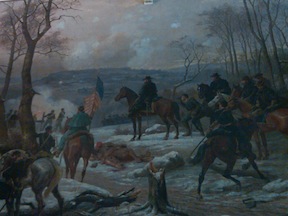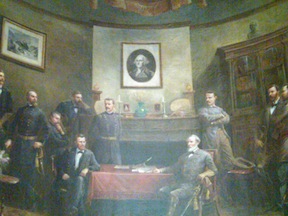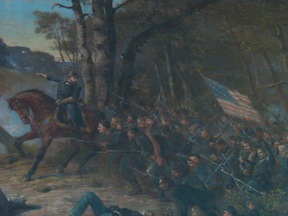Ulysses S. Grant’s Long Road from Donelson to Lowell
 February 15, 1862 found Ulysses S. Grant sitting on horseback in the snow, staring at the collapsed line along his right. Confederates had pushed out from Ft. Donelson early that morning, while Grant had been downriver talking to Admiral Andrew H. Foote. He was far enough away that he hadn’t even hear the fighting and had to be informed by a staff member that things back at Donelson had, um…gone wrong.
February 15, 1862 found Ulysses S. Grant sitting on horseback in the snow, staring at the collapsed line along his right. Confederates had pushed out from Ft. Donelson early that morning, while Grant had been downriver talking to Admiral Andrew H. Foote. He was far enough away that he hadn’t even hear the fighting and had to be informed by a staff member that things back at Donelson had, um…gone wrong.
Grant returned to a crumbling line and grumbling officers. “The army wants a head,” one of them muttered. Unperturbed, Grant told his subordinates, “Gentlemen, the position on the right must be retaken.”
So imagine my surprise when I came across Grant, sitting on horseback in the snow, overseeing the action, high above the reference room in the Pollard Memorial Library in Lowell, Massachusetts.
I was in Lowell to check out the national park there (which is fantastic, by the way) and only by chance happened upon an NPS brochure titled “Lowell, MA Civil War Map and Guide.” The self-guided tour has thirteen stops, including some beautiful old churches, a couple nifty monuments (which I’ll post about later), and the gravesite of Lowell’s most infamous Civil War native, Major General Benjamin “Beast” Butler. I had no idea old Spoons was from Lowell, but in fact, the man was an untiring champion for his home city.
Stop four on the tour directed me to the Pollard Memorial Library, opened in 1893 as a Civil War “monument to the heroism of the past and a storehouse of knowledge for the future,” says the library’s website. The exterior of the building features three bas-relief sculptures of Civil War soldiers carved into a turret-like tower near the front door.
In 1915, a massive fire gutted the building and nearly destroyed it. The stalwart Yankees of Lowell rebuilt.
That’s when Ulysses S. Grant came to town.
By that time, Grant had been dead, of course, for some thirty years. The great War Hero’s popularity had waned some, and America feared a new war, broiling on the horizon in Europe.
So perhaps that’s why, when a trio of large Grant paintings came up for sale, the folks of Lowell got themselves an incredible deal. “The Hall’s major new embellishments, its three Civil War murals, were a bargain,” says the library’s website.
 The paintings depict three key moments in Grant’s Civil War career: The Battle of Ft. Donelson, the Battle of Shiloh, and Lee’s Surrender at Appomattox. The artist: French-born painter Paul Philippoteaux, best known as the man who painted the six-ton, 100-yard-long Gettysburg Cyclorama.
The paintings depict three key moments in Grant’s Civil War career: The Battle of Ft. Donelson, the Battle of Shiloh, and Lee’s Surrender at Appomattox. The artist: French-born painter Paul Philippoteaux, best known as the man who painted the six-ton, 100-yard-long Gettysburg Cyclorama.
“The Memorial Hall canvases were painted for traveling carnival display and were purchased by the City of Lowell for a mere $1,500 from the Griffin Amusement Company,” says the library’s website.
I can’t tell how big the paintings are exactly, and no one online seems to know, either, but they’re big enough that I could have a small lawn party under each one if I stretched them out like canopies. They certainly aren’t cyclorama-big, but they’re not small, either.
The Appomattox painting hangs in a curved alcove at the rear of the room. It’s a marvelously romanticized depiction of the surrender—as most of them are—with far more Confederates present than were actually in the room. With Grant and Lee sitting at a desk at the center of the painting, it looks like the kind of thing you’d see dominating a room like this in a library.
 Above the door, taking up the entire right side of the upper wall, hangs the painting on Grant at Shiloh. As in the Donelson painting, Grant’s on horseback, but his pose is much more active. He’s pointing the way forward for his men, who literally materialize out of the forest on the right side of the painting toward an open area, filled with far-off Confederates, on the left.
Above the door, taking up the entire right side of the upper wall, hangs the painting on Grant at Shiloh. As in the Donelson painting, Grant’s on horseback, but his pose is much more active. He’s pointing the way forward for his men, who literally materialize out of the forest on the right side of the painting toward an open area, filled with far-off Confederates, on the left.
The Donelson painting hangs as a counterpart to Shiloh, filling the entire upper wall left of the doorway. Grant sits in the painting just slightly to the right of center; it’s the American flag that gets centerstage. Philippoteaux employs several artistic techniques to making sure a viewer’s eyes gravitate toward the flag, too: white space around it and brighter colors than anywhere else in the picture.
 There’s much movement in the image: canons billowing smoke, staff members reigning in horses, wounded soldiers milling about fires. Two men, one of the black in a bright red shirt, also designed to attract attention, carry a casualty to the rear in the lower-right corner. Even the flag looks like it’s about to take a lazy flap in the breeze.
There’s much movement in the image: canons billowing smoke, staff members reigning in horses, wounded soldiers milling about fires. Two men, one of the black in a bright red shirt, also designed to attract attention, carry a casualty to the rear in the lower-right corner. Even the flag looks like it’s about to take a lazy flap in the breeze.
Amidst all that Grant sits still, stoic, watching. “Gentlemen,” he’s about to say, “the position on the right must be retaken.”
Grant knew, as he’d know at Shiloh a few months later when Confederates would again have him on the ropes and pushed back, that initiative would be the key. “We’ll lick ‘em tomorrow,” he’d tell Sherman after that first disastrous night at Shiloh—and he would. He’d take the initiative and snatch victory from defeat, just as he’d later do at Vicksburg and Chattanooga.
“The one who attacks first now will be victorious,” Grant said at Donelson. “The enemy will have to be in a hurry if he gets ahead of me.”
The subsequent counterattack Grant launched on his right succeeded as much because of Confederate passivity and ineptitude as anything Grant did, although the federals did manage to plug the vast hole Confederates could’ve used to escape. It would be an attack on Grant’s left that would actually break the Confederate position. Grant’s success would lead the Confederates, on February 16, to ask for terms. “No terms except unconditional and immediate surrender can be accepted,” he famously replied.
As I stand in the reference room in the library and Lowell and gaze up at that giant painting of Grant, I watch him as he watches the battle. I wonder what he’s thinking. He’s face is too small, and turned mostly away from me, and he’s hanging too high on the wall for me to really see. My neck will get a crink in it from looking up for too long. But I wonder. I wonder.
Six years ago or so, my daughter and I visited Donelson together. Parts of the park were closed because of a nesting pair of bald eagles. If that didn’t have iconic value as the U.S. laying claim to Confederate territory, I don’t know what would. But that’s not the image that I took away from our visit, nor was it the beautiful view of the Cumberland River down by the lower gunpits.
Rather, it’s Philippoteaux’s snowy landscape, with Grant situated at the center, that sticks with me even though my daughter and I visited in the summer. The park’s small bookstore sold prints of the painting, maybe eighteen inches long. We paid a dollar or something ridiculously cheap. It was a major Civil War purchase for my daughter, though, who was devoted almost exclusively to Stonewall Jackson. A picture of Grant was a major, major departure.
The print of Grant at Donelson would hang in her bedroom for years. It finally came down last year when she repainted her room. Her Jackson stuff went back up, but Grant did not. Last I saw him, he was propped against the wall in the upstairs hallway, just outside her door.
I never expected to find Grant at Donelson here, in Lowell, Massachusetts, in the library. It’s as though he’s come to the city to tell Butler, “Tell you what: I’ve got this. Why don’t you head on down to the James Peninsula. I’ve got things here covered.”
Grant’s long road to Lowell started on horseback, in the snow, canons belching smoke around him, not far from the banks of the Cumberland, 150 years ago today.

This is one of the loveliest posts I have read here. There is something deeply personal about it that is very touching. It reminds me of the one you did about the Stonewall House–both stay in my memory, reappearing at unbidden times. Just very nice! Thanks.
Thanks, Meg. My best times on the battlefields have been with my daughter.
Thanks for posting this about Grant. it’s one of my favorite paintings.
Nice post and very well written. Although I live in southeastern Mass. I have never explored Lowell’s rich history. You mentioned Ben Butler. Lowell is also the final resting place of General Adelbert Ames, one of the Union’s best division commanders and son-in-law to Butler, and Major Henry L. Abbott of the 20th Massachusetts who was killed at the Battle of the Wilderness and whose death was universally lamented from his brigade commander, A.S. Webb, to the commanding General, George Meade.
I’m looking for reputable civil war memorabilia dealers in Mass. Anyone know of any fair-priced ones? Thanks!